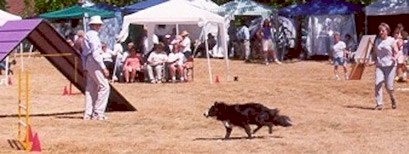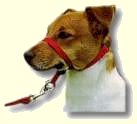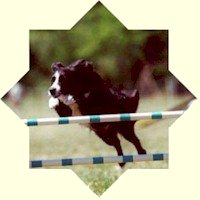Teaching rights and
lefts...
 For
quite some time American Sandy Birdsall had debated with herself about teaching directional
commands to her Border Collie. She could think of lots reasons why not to bother, mostly to due
with the fact that she's mildly dyslexic. In the end, she decided to give it a try. This is the
diary she wrote (with Agilitynet in mind) while she was training her dog Flyer to do rights and
lefts. For
quite some time American Sandy Birdsall had debated with herself about teaching directional
commands to her Border Collie. She could think of lots reasons why not to bother, mostly to due
with the fact that she's mildly dyslexic. In the end, she decided to give it a try. This is the
diary she wrote (with Agilitynet in mind) while she was training her dog Flyer to do rights and
lefts.
This was the situation...
I had become very comfortable
looking at the backside of my fast-moving Border Collie. In fact, itís about all I got to see
of him on the agility course. With Flyer often running an obstacle or two ahead of me, I was
sometimes forced to use a call-off to turn him. This was inefficient and risky. After our first
year of agility competition, it was apparent that we needed a few more navigational tools in
our toolbox.
For months I had fought with myself about
teaching rights and lefts. I could list a dozen reasons why not to. Number one, I'm somewhat
dyslexic. If I improvise a sudden 'right!' command, what I really mean will probably be 'left!'
So my use of right and left would have to be well planned, rehearsed and used sparingly.
Goal and approach
I would need the left and right
commands to have the power of a call-off command in order to redirect my hard driving dog. The
goal was an instant response (with minimal forward movement) and turns as close as possible to
90 degrees.
 I
thought about the mechanics of a dog turning. If I could teach my dog that right and left meant
'turn your head' to the right or left, then his body would naturally follow. I wanted a
tool to effectively show him what right and left meant. For this I chose a Gentle Leader
ģ Headcollar. It would
allow me to gently direct the dogís muzzle with a precision that was not possible with a neck
collar. I
thought about the mechanics of a dog turning. If I could teach my dog that right and left meant
'turn your head' to the right or left, then his body would naturally follow. I wanted a
tool to effectively show him what right and left meant. For this I chose a Gentle Leader
ģ Headcollar. It would
allow me to gently direct the dogís muzzle with a precision that was not possible with a neck
collar.
Caution:
The head collar must be properly fitted and rechecked daily for proper fit. I
would need to ensure that my dog never received a jerk to his neck while wearing it. This could
result in injury to the back of his neck.
What follows is a diary of my thoughts
and experiences during the initial training. While I am pleased with the results, there are
things I will do differently next time. They are covered at the end of this article along with
lessons learned.
The Starting Line
- My dog knew the commands 'stand',
'wait' and 'catch'
- Equipment: a small diameter (1/4
inch) leather lead, a Gentle Leader ģ
Headcollar, and my dogís best motivator Ė a ball.
- We trained three times a day for about
five minutes each session.
Day 1
Introduced the headcollar
Once the headcollar
was properly fitted, I began tossing the ball to Flyer using the command 'catch.' I marked each
good catch with an excited 'yes!'
Important: The headcollar was removed as soon as each training session ended.
Day 2 -
Began teaching the words 'right' and 'left'
Flyer visibly brightened
when the headcollar appeared. I tossed the ball to him several times in reward for his good
attitude. Then, attaching the six-foot lead, I asked him to 'stand' and 'wait' while I stepped
directly behind him facing the same direction. He looked back at me a couple times over his
right shoulder. I waited until he relaxed and looked straight ahead, then
gently
turned his head to the right with the leash while saying 'right!'
in a very excited tone of
voice. At the moment his head reached a point where we could make eye contact, I tossed the
ball to him, praising lavishly as he caught it. We repeated the training sequence with a left
head turn, ball toss, and praise.
Important: It was necessary to
make sure the lead was hanging loosely to the side I would be
turning him so as not to telegraph my intentions. I
never used it to jerk
his head around.
Day 3 -
Continued as in Day 2
The training sessions
continued as described above.
Day 4
- Continued teaching
words; removed headcollar when anticipation appeared
Important: Today Flyer
started offering a right or left head turn on his own from the stand
position. I
immediately replaced
the headcollar with his leather buckle collar to avoid all
possibility of a neck injury.
In fact, it was becoming difficult to get
him to look straight ahead. If I wanted him to make a left turn, I would sometimes have to wait
until he was looking at me from his right. Then I would give the 'left' command and reward with
the ball toss. If he made a mistake I simply ignored it and started over.
Day 5
- Removed lead;
added my body language
We went off lead and I
added my body language to simulate what he could expect to see from me on the course. The
training sequence went: stand my dog, step behind, give the command 'right' while at the same
time pivoting my body to the right, tossing the ball to him at about the 90-degree point, and
praise. Restart and work the left turn.
 Day
6 -
Continued as in Day 5; added 'oh oh' feedback Day
6 -
Continued as in Day 5; added 'oh oh' feedback
Instead
of ignoring a wrong response and starting over, I began responding with 'oh, oh', which means:
thatís not the behavior I wanted, letís try again. Then I would restart the exercise. About
this time I also started worrying (OK, obsessing) about what I was really teaching him. Was he
actually learning what right and left meant? Did I really care as long as I got the result I
wanted on the agility course?
Day 7
- Trouble
Problem.
Today my dog was sooooooo excited today about the probability of playing the game that he was
offering potentially dangerous behavior. I started to train as usual this morning, leaving him
in a stand and stepping behind him. Then he started wildly (and I do mean wildly) thrashing his
head to the right and then to the left to look at me over his shoulder in anticipation of the
ball toss, eyes gleaming like a Christmas tree. I released him, quietly telling him he was a
good boy, and ended the session right there. My confidence sunk to a new low. I took the
remainder of the day off to think about it.
OK, all you behaviorists out there
are snorting about now. You saw this one coming, right? Iím
embarrassed to say I didnít.
Day 8
-
Provided forward focus
Letís face it. On the agility
course, my dog is not going to be that interested in me. Never has been, never will be. What I
needed was some excitement happening right in from of him to simulate the forward momentum of a
course. I got a second ball.
I stood my dog, placed ball #1 out about
ten feet out in front of him and returned to stand behind. Would you be shocked to hear that he
broke his stand and wait? Yep, he did. I issued a soft 'hugh ugh', which is my mild verbal
correction. It simply means: I donít like that behavior, donít do it again.
We started over. I stood him, placed the
ball in the same spot, and returned behind him once again. My dog was now pointed straight
ahead and visibly struggling with his desire to retrieve the ball, but the wild side-to-side
head thrashing was gone. 'Right!' I said, in an excited tone of voice as I pivoted to the
right. Miracle of miracles! He made a 90-degree right turn, planted his feet, caught ball #2 as
I tossed it to him, and the two of us had a celebration!
We started again. I stood him,
placed ball #1 out in front, but this time I
turned 90 degrees to my right giving him the hand signal and
verbal command to 'get out, get it' Ė sending him away from me and down the hallway to retrieve
ball #1. Next I turned him around to face the other side of my living room. We repeated the
above training sequence with a left turn, ending with the get out exercise from the standing
position. We were back on track.
Day 9
- Continued alternating
between rights, lefts and get outs
I continued as in
Day 8 except now I was tossing
ball #1 ten feet out in front.
Day 10 -
Added more distance between me and my dog
The training was
continuing to go well. I moved back three to four feet behind him.
Day 11
- Added more
variables (tossed/placed balls, 180-degree turn exercise, etc.)
I now varied between
tossing balls in front of him and placing them around the room before he was brought in. For
the 180-degree turn I would stand him, pivot around to face him, then
hand signal and command: 'turn
- get out,
get it' to a ball that had been placed behind him.
Day 122
- Continued with
variables; added yet more distance
I increased the distance
to six feet and got correct responses throughout our first two training sessions of the day.
Gathering up all my courage, I took our third training session of the day outdoors to the front
lawn where four agility jumps were arranged in a jumping square. 'Over, left over' and 'over,
right over' Ė with the ball thrown to reward each 90-degree turn.
   
Then, 'over, left come' and 'over, right
come' to get turn backs Ė rewarding his good behavior by throwing the ball between my legs as
he returned to me.
Day 13
- Incorporated new
behavior into daily routine
The new behaviors were
moved into maintenance today. This is a short, one-to-two minute training session just prior to
Flyerís morning and evening meal.
Day 14 Tested new
behavior at class
We tried a right turn on a
jumperís course tonight and Flyer executed it perfectly! Someone remarked, 'Hey! I didnít know
your dog could do a right turn. When did you teach that?'
Lessons learned and relearned
- Forward focus
- Provide a small amount of forward focus from the beginning,
slowly increasing distractions as the dog gains proficiency.
- Be unpredictable -
Frequently change the order of commands so the dog canít
anticipate.
- Regarding trouble
Ė There is great value in knowing when to stop a training
session.
It is important to be prepared to quit
for the day when behavior appears that is not understood, or if youíre not getting the results
you want.
 About
the headcollar About
the headcollar
I experimented with the
headcollar in an effort to teach the words and associated head turn
before I added my body
language. Will I use the headcollar with my next dog? Probably, because I like the results I
got this time. Was the headcollar really needed? Maybe, maybe not. The turns can certainly be
taught without it.
You be the judge
Does my dog really know the
difference between right and left? IĎm not certain. What I do know is that when I say 'right',
I get an instant response and a 90-degree right turn from him. And when I ask for a 'left', I
get an instant response and a 90-degree left turn.
Thatís good enough for me.
 Sandy
Birdsall has been training and
showing dogs in obedience for 27 years. Her two year old Border Collie, Flyer, is the first dog
she has trained in agility. Sandy
Birdsall has been training and
showing dogs in obedience for 27 years. Her two year old Border Collie, Flyer, is the first dog
she has trained in agility.
Sandy lives in Issaquah, Washington, USA
with her husband, Mike, where she works as a Web designer for The Boeing Company. She may be
contacted at sandy_birdsall@uswestmail.net.
© Sandy Birdsall 2001
Photo by Nicole Watts
Photo from Clean Run:
http://www.cleanrun.com/
All other artwork by Sandy Birdsall
Gentle Leader ģ Headcollar
From Ann Thomas, Katie (BC) & five
puppies
I really enjoyed this article. I
have a problem with left and rights too. It really comes out under pressure. I have to memorize
course to HEART...no room for thought out there! Thanks for the info and that I'm not the only
one!
(11/08/01)
|